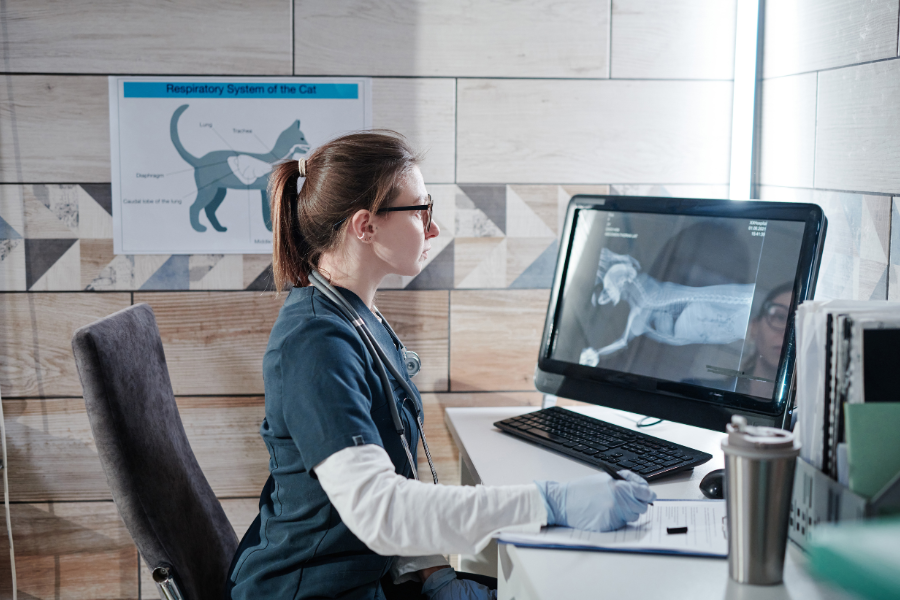In recent months, many veterinary practices have taken an environment of economic uncertainty and turned it into a springboard for operational innovations. Where we once saw a lag in technology adoption sometimes made worse by decision fatigue, more and more practices are now opening up to the idea of new solutions like productivity tools that can help them tackle today’s workforce, workflow and well-being challenges.
With that willingness in mind, now is a critical moment to take stock of current economic realities, but more importantly, begin to strategize for longer-term economic trends on the horizon. Let’s review current trends, the long-term forecast and what steps you can take now for maximum adaptability to reap the desired benefits of your practice moving forward.
Today’s ‘everything is weird’ economy
The U.S. economy and the veterinary market are inextricably linked, which means practices must be ready to pivot when global disruptions, demographic shifts and other macroeconomic forces collide. Current economic conditions are admittedly a bit of a head scratcher. For example, inflation hit a 40–year high in June 2022, rising to 9.1%. Fortunately, that number has waned a bit to 8.2 as of September but certainly looms large as consumers struggle to make ends meet, especially down the grocery aisle. Skyrocketing rents and lack of affordable housing are putting many household budgets past the breaking point.
But rather than the unemployment surge one might expect to accompany such an inflation increase, we’re instead seeing an incredibly strong labor market emerge with unemployment at just 3.5% as of September 2022. Meanwhile, the U.S. gross domestic product managed to inch past the estimated 2.4% annualized rate for 3Q22, coming in at 2.6%.
When combined, do these three factors spell recession? That’s the question dominating headlines, but perhaps it’s the wrong question to ask. The real question is around the financial health of your clients, partners and staff – and how financially secure they feel. Certainly, higher prices from inflation hurt affordability on all sides of the equation, but without the layoffs and unemployment that normally exacerbate the impact of price hikes, not every aspect of financial health is on the decline.
It’s important not to get too bogged down in current economic realities when now is the moment to prepare for long-term success. By building your resilience now for what’s to come, you can avoid the scramble of 2020 and capitalize on the positive momentum around innovation already in place or to come. Ultimately, we don’t know what will happen with the economy, but issues of labor shortage, productivity and affordability will persist. Let’s examine why and what you can do about it.
Two future economic realities
Demographic drought
Beyond the “great resignation,” which saw over 4 million people quit their jobs across a range of age groups, the U.S. labor force participation rate is a cause for concern in the long-term given the aging out of a significant cross-section of the workforce—baby boomers. According to the U.S. Census Bureau, by 2030, all baby boomers will be at retirement age, with an average of 10,000 hitting retirement age each day from now until then.
Compounding the problem is the fact that, according to the Organization for Economic Co-operation and Development (OECD), birth rates in the U.S. fell 30% after the Great Recession and continue to reach new all-time lows. And thanks to COVID-related restrictions and other legal regulations, immigration numbers have also fallen to record lows. Compare, for example, the 559,536 immigrant visas issued in 2017 with the 285,069 granted in 2021.
In short, way too many people are retiring and far too few are waiting in the wings to replace them. That means the current workforce shortage in veterinary medicine only stands to worsen over time. Unfortunately, there’s no simple fix for a dwindling talent pool. While you can combat the negative impacts of inflation with fiscal instruments, you can’t conjure more workers out of thin air. As a result, it’s time to start thinking creatively and strategically about how to empower your existing teams to work more efficiently in a culture that promotes well-being.
The harrowing out of the middle class
As the workforce shrinks, inequalities across wealth and health are also creating significant social fractures. After an initial spike due to stimulus payments, disposable income has dipped below its pre-COVID trajectory according to the U.S. Bureau of Economic Analysis. Inflation plays a role here, since household necessities now take up a sizable portion of a family’s budget. These factors negatively impact your clients’ ability to pay for services as we as an industry strive to keep veterinary care financially accessible for all pets.
Moreover, household incomes have risen considerably since 1970, but those of middle-class households have not climbed nearly as much as upper-income ones. According to the Pew Research Foundation, upper-class household income increased 69% from 1970-2020 compared to 50% for the middle class and 45% for lower-income households. As the middle class shrinks, it’s critical to consider how your practice can best serve all clients and differentiate itself to stay competitive within your market.
Two key economic realities to keep in mind
- The demographic drought: The U.S. economy is in for a sustained labor force crisis that COVID pushed fast-forward on.
- The harrowing out of the middle class: The middle class is no longer the bedrock of our economy, impacting what a typical household can afford.
What can you do now to prepare for tomorrow’s economic challenges and opportunities?
1. Reduce & eliminate debt
In a tight economic environment, flexibility is key. Making changes to your practice almost always involves engaging new resources, which is difficult to do if you’re overextended financially. A tactically effective place to start is to make sure you’re not saddled with debt and/or overleveraged at your practice. The same goes for personal household finances too. Work to pay off debt and free up cash flow and/or move debt to lower lines of interest.
2. Differentiate & communicate
Are you telling a compelling story about your practice to your new and existing clients? What about your future employees? Sometimes, increasing your competitive advantage isn’t about making yourself different. It could be making sure people know who you are, and how you can help them, through a strong marketing and communication strategy that disseminates the right message. Can you clearly communicate your practices’ strengths and translate them into benefits to your target audience? And don’t forget about your employer brand. In a tight labor market, be sure to engage with potential future hires and provide them with a compelling snapshot of your practice’s positive, engaging culture—especially when it comes to how you support well-being for all staff.
3. Innovate & simplify
Disruption is always around the corner, so now is the time to start thinking about how you can innovate your practice in ways big and small to stand the test of time against shifting market dynamics. Whether you’re ready to launch a new operating model or make smaller strategic interventions, there are plenty of options to consider. Could you expand your scope of services to create a more all-inclusive experience for clients through, for example, boarding and grooming? Are there services your practice provides, or could provide, that no one else in your local market has the ability to offer? Maybe there are updates to your physical location that can better shape the employee and client experience. Remember that not every improvement needs to be seismic or technological. Improvements to foundational elements like culture, process and scheduling will pay dividends in the long term.
Happily, the events of the last three years have prompted many practices to evolve their thinking to a more open-source mindset. How can you tap into your professional network to collaborate for mutual benefit? Consider partnerships with startups offering innovative solutions as a way to bring your practice into the future.
4. Optimize your staff
To combat productivity and workforce challenges, it’s critical to make sure you have the right people in the right roles with the right tools. From there, take a hard look at average appointment lengths and types—and how they are conducted. Are you leveraging automation and technology to free up your people and save time on routine tasks? What training opportunities would empower your teams on the job? Sometimes the best way to answer some of these questions is to simply listen to your employees. They often have the best ideas on how to improve day-to-day processes and procedures and create a more positive work environment.
The key here is to make the delivery of veterinary care easier for your staff and more affordable for your clients. Take a look at how process efficiency can bolster practice productivity. Relying on price increases to steady revenue is not an economically sustainable strategy. Rather, focusing on tightening up your bottom-line costs while dually supporting the ability of your staff to deliver is the best approach.
5. Build & nurture relationships
Veterinary medicine is, at its core, an industry rooted in relationships. You need to make sure you’re investing time and energy in the relationships that make up your business—namely those with your team, clients, vendors and suppliers, and peers.
Teams
In an atmosphere of high turnover, there’s no shortcut to truly valuing and uplifting your staff. Do you know their families, goals, interests and hobbies outside of work? You must build strong relationships with your employees and act on behalf of their well-being in order to avoid high turnover.
Clients
Think of how you can extend an interest in your clients and their pets beyond the transactional. Do you consistently provide value in a non-promotional manner? Can you improve how you communicate with clients? Do they know you care? Remember, they’re marketed to every day, so you need to make sure your messages and interactions resonate on a personal level.
Vendors/suppliers
Without equipment and supplies, you cannot succeed. Build your supplier network wider and deeper than seems necessary, and make sure you’re investing in these relationships over time. Because when disruption strikes, you can’t suddenly force those bonds for the sake of convenience.
Peers
All around the country, other practice owners are facing the same economic forces as you and working to future-proof their hospitals. No one understands your challenges quite like your peers, and by connecting with your broader professional network, you unlock a wealth of professional insights, practical solutions and support.
With VMG, you’re never alone
As you prepare for the challenges ahead, a VMG membership can help you get a jumpstart on key action items that will set your practice up for long-term success. Our study groups connect you with fellow practice owners so you can escape isolation, receive support and discuss validated solutions to pressing problems. That’s indispensable intellectual capital – and lasting relationships – at your disposal, year after year. You’ll also get the tools you need to best support your practice health, like financial benchmarking and operational support, while connecting your staff to the professional development and training they need to excel. And our industry leading preferred partnership program delivers the direct economic benefits and financial savings to elevate the profitability of your practice.
Our members agree: joining a VMG is among the best business decisions you will ever make. Let’s discuss how a VMG can empower you to make your practice thrive for the long haul. Click here to connect with us on whether a VMG membership is right for you.
Already a VMG member? Be sure to share this resource with your professional network.







